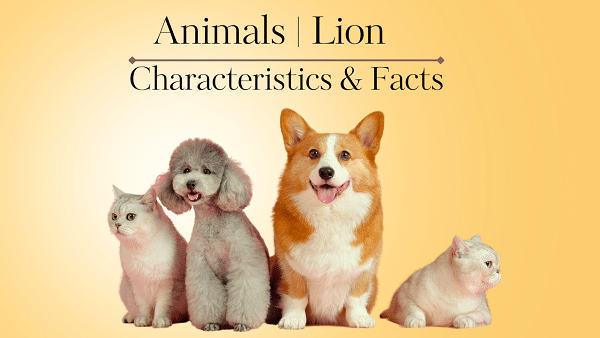
Lion Definition | Characteristics & Facts
Lion Definition
The lion (Panthera leo) is a large, carnivorous mammal and a member of the Felidae family. It is known for its majestic appearance, strength, and iconic roar.
Lion General Characteristics & Facts
Appearance
Lions have a muscular build, with males being larger than females. Male lions typically have a mane of long hair around their necks, which varies in color from blond to black. The coloration of their fur is usually tawny yellow or gold, with white underparts. They have a rounded head, strong jaws, and sharp teeth.
Social Structure
Lions are the only truly social cats and are known for living in groups called pride. Related females of pride consist of their offspring with a few adult males. The males defend the pride's territory and are responsible for protecting the group from intruders.
Hunting and Diet
Lions are apex predators and primarily feed on large ungulates such as zebras, wildebeests, and antelopes. They are skilled hunters and often employ group strategies when hunting. Females are usually the primary hunters, while males may join in for larger prey. Lions have a strong bite force and sharp retractable claws that help them bring down their prey.
Habitat
Historically, lions inhabited diverse habitats throughout Africa, including savannas, grasslands, and semi-arid regions. However, due to habitat loss and human activities, their range has significantly decreased. They require open spaces to hunt and access water sources.
Conservation Status
Lions are currently listed as vulnerable species by the International Union for Conservation of Nature (IUCN). The primary threats to their survival include habitat loss, human-wildlife conflict, poaching, and the decline of their prey species.
Symbolism and Cultural Significance
Lions have long been regarded as symbols of strength, courage, and royalty. They feature prominently in various cultures, including African folklore, mythology, and heraldry. Lions are often associated with power, leadership, and nobility.
Read our Animals Encyclopedia with Complete Facts
Physical Characteristics of Lion
- Size: Adult male lions are generally larger than females. They typically measure around 4.5 to 6.5 feet (1.4 to 2 meters) at the shoulder and have a total body length of 5.6 to 8.5 feet (1.7 to 2.6 meters). The tail of a lion adds an additional 2.6 to 3.3 feet (0.8 to 1 meter) in length. Adult male lions usually weigh between 330 and 550 pounds (150 to 250 kilograms), while females weigh around 265 to 395 pounds (120 to 180 kilograms).
- Mane: One of the distinctive features of male lions is their majestic manes. The mane is a thick growth of hair that surrounds the head and neck and varies in color from blond to black. The mane serves as a visual display of strength and dominance and typically grows fuller and darker as the lion ages.
- Body Structure: Lions have a muscular and compact body built for strength and agility. They have a deep chest, powerful forelimbs, and strong jaws. Their hind limbs are longer and more muscular, enabling them to generate great leaping and sprinting power.
- Fur: The fur of a lion is short, coarse, and tawny in color, ranging from light buff to yellowish-brown.Inner legs and belly are lighter in color. Some lions may also have black spots on their bodies, particularly when they are young, but these spots tend to fade as they mature.
- Head and Face: Lions have a large and rounded head with a well-developed muzzle. They possess a strong jaw equipped with sharp canine teeth and molars for tearing and crushing their prey. Their eyes are typically yellow or amber in color and are set forward on the face, providing binocular vision for better depth perception during hunts.
- Ears: Lions have short and rounded ears that are highly sensitive to sound. These ears are capable of rotating to detect sounds from various directions, helping them locate prey or communicate with other members of their pride.
- Teeth: Lions have a set of formidable teeth adapted for their carnivorous diet. Their canines are long, sharp, and used for capturing and killing prey, while their carnassial teeth are designed for cutting through flesh.
Continue To Explore All Animals That Start With L
Scientific Classification of Lion
Kingdom: Animalia
Phylum: Chordata
Class: Mammalia
Order: Carnivora
Family: Felidae
Genus: Panthera
Species: Panthera Leo
Key Locations of Lion
- Sub-Saharan Africa
- Gir Forest National Park, India
- Serengeti National Park, Tanzania
- Maasai Mara National Reserve, Kenya
- Kruger National Park, South Africa
- Okavango Delta, Botswana
- Etosha National Park, Namibia
- Hwange National Park, Zimbabwe
- Ruaha National Park, Tanzania
- Ngorongoro Conservation Area, Tanzania
View All A-Z Animals List
Lion FAQs
What is a lion's average lifespan in the wild?
It has about 10 to 14 years in the wild.
Are lions social animals?
Yes, they belong to social animals and live in groups called pride. A pride usually consists of related lionesses, their cubs, and a small number of adult males known as coalition males.
How fast can lions run?
Lions are capable of reaching speeds up to 50 miles per hour (80 kilometers per hour) in short bursts. However, they can only maintain such high speeds for relatively short distances.
What do lions eat?
Lions are apex predators and primarily feed on large herbivores, such as zebras, wildebeests, buffalo, and various antelope species. They are opportunistic hunters and will also scavenge on carrion when the opportunity arises.
Do male lions participate in hunting?
While lionesses do the majority of the hunting, male lions may join in when targeting larger prey or during periods of scarcity. However, their primary role is to defend the pride's territory and protect the young.
How do lions communicate?
Lions use a range of vocalizations, including roars, grunts, growls, and meows, to communicate with each other. They also employ body postures, facial expressions, and scent markings to convey messages and establish dominance.




